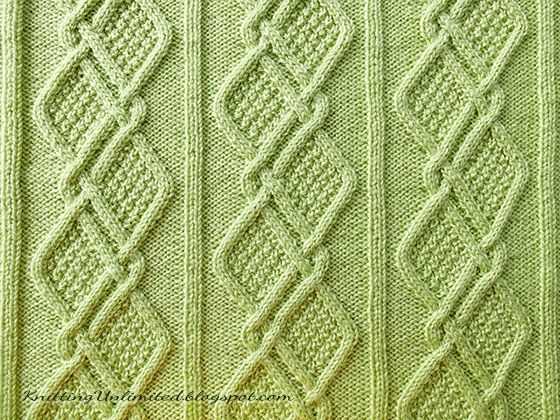
Knitting patterns are a beautiful and versatile way to create unique and intricate designs in your knitted pieces. One popular pattern that adds a touch of elegance and sophistication to any project is the diamond stitch. The diamond stitch is a classic knitting pattern that features a series of diamond shapes, creating a stunning textured effect.
The diamond stitch, also known as the diamond cable stitch, is a relatively simple yet visually striking pattern that can be used in a variety of knitting projects. Whether you’re creating a cozy scarf, a stylish sweater, or a decorative blanket, the diamond stitch is a great choice for adding a touch of style and complexity to your work.
To create the diamond stitch pattern, you’ll need to have a basic understanding of knitting cables. The pattern involves crossing stitches over one another to create the diamond shape. Once you get the hang of the technique, you’ll be able to create rows of gorgeous diamond shapes that will impress everyone who sees your finished project.
If you’re ready to take your knitting skills to the next level and add a touch of elegance to your projects, the diamond stitch is the perfect pattern to try. Whether you’re a beginner or an experienced knitter, the diamond stitch is a versatile and rewarding pattern that will take your knitting to new heights. So grab your knitting needles and start experimenting with the diamond stitch pattern today!
Diamond Stitch Knitting Pattern
The diamond stitch knitting pattern is a classic and elegant design that adds texture and visual interest to any knitting project. It is a popular choice for sweaters, scarves, blankets, and other items where a touch of sophistication is desired. This pattern features a series of diamond-shaped motifs that are created by alternating knit and purl stitches, resulting in a beautiful and intricate pattern.
To create the diamond stitch pattern, you will need to be familiar with basic knitting stitches such as knit, purl, yarn over, and decreases. The pattern is worked over an odd number of stitches and rows, making it easy to adapt to different sizes and projects. It is also reversible, meaning that both sides of the fabric will display the same pattern.
To start the diamond stitch pattern, cast on the desired number of stitches and work a few rows in a basic knit or purl stitch. Then, begin following the pattern chart or written instructions, which will guide you on where to place the knit and purl stitches to create the diamond shape. Pay attention to any special instructions for decreases or yarn overs, as these will add the shaping and detail to the design.
As you work the diamond stitch pattern, you will notice the intricate diamond shapes emerging row by row. The pattern can be challenging at first, but with practice, it becomes easier to follow and memorize. It is a great pattern for intermediate or advanced knitters who are looking for a new challenge and a stunning finished result.
Overall, the diamond stitch knitting pattern is a beautiful and versatile design that can elevate any knitting project. Its elegance and sophistication make it a timeless choice for garments and accessories. Whether you choose to knit a sweater or a scarf with this pattern, you can be sure that it will be a stunning addition to your wardrobe or a cherished gift for someone special.
What is a Diamond Stitch Pattern?
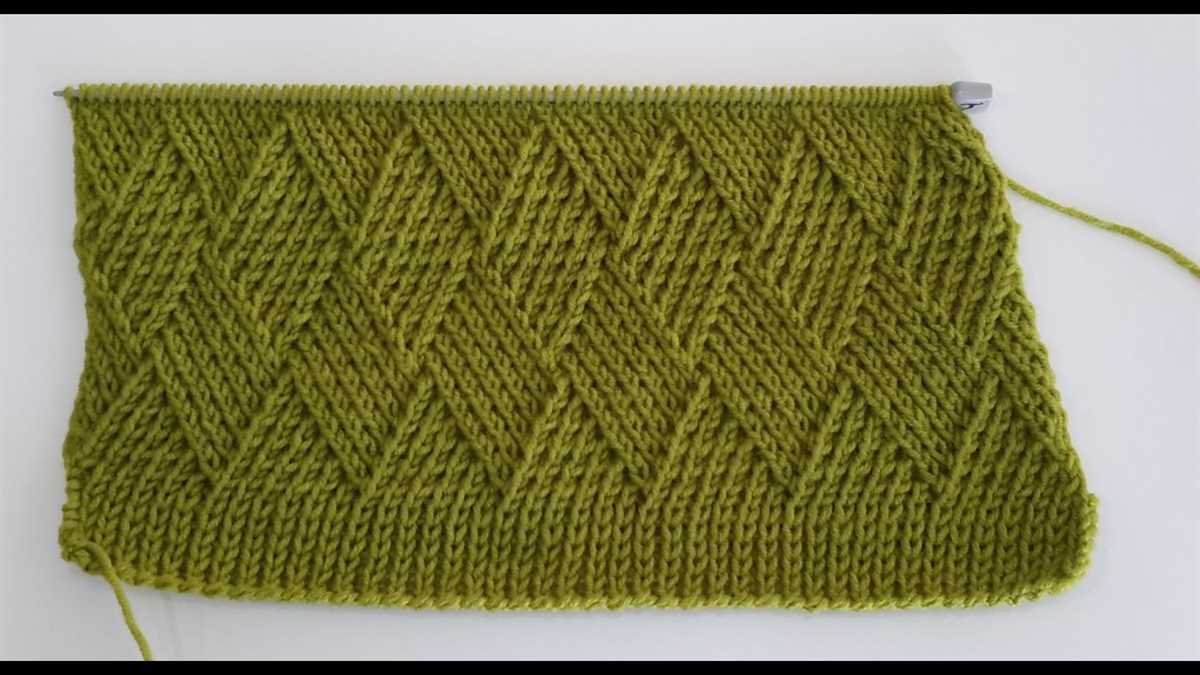
The diamond stitch pattern is a popular knitting technique that creates a unique diamond-shaped design on fabric. It is characterized by a series of diagonal lines that intersect to create the diamond shape. This pattern is commonly used in various knitting projects, such as scarves, shawls, blankets, and even sweaters.
To create the diamond stitch pattern, knitters typically follow a specific set of instructions or a chart that indicates the placement of knit and purl stitches. The pattern usually requires a multiple of stitches, and the number of rows needed to complete the diamond shape may vary depending on the desired size and design.
When working on the diamond stitch pattern, it is essential to pay attention to stitch counts and pattern repeats to ensure the integrity of the diamond shape. Knitters may need to use markers or highlighters to keep track of the stitches and rows in complex patterns.
The diamond stitch pattern can add texture and visual interest to knitted items, making them more visually appealing and unique. It offers an elegant and sophisticated look to finished pieces, making them suitable for both casual and formal occasions. With its versatility, the diamond stitch pattern is a favorite among knitters of all skill levels.
Overall, the diamond stitch pattern is a beautiful and versatile design that can elevate any knitting project. Whether you’re a beginner or an experienced knitter, incorporating this pattern into your work can add a touch of elegance and style. So grab your knitting needles and give the diamond stitch pattern a try!
How to Knit the Diamond Stitch Pattern
Knitting the diamond stitch pattern can add a beautiful texture to your projects. Whether you want to create a cozy sweater, a warm scarf, or even a blanket, this pattern can be a great choice. Here is a step-by-step guide on how to knit the diamond stitch pattern.
- Casting on: Start by casting on an even number of stitches. The diamond stitch pattern requires an even number of stitches to create the desired effect.
- Row 1: Begin the first row by knitting the first stitch. Then, bring the yarn to the front of your work and slip the next stitch purlwise. Repeat this pattern of knitting one stitch and slipping one stitch until the end of the row.
- Row 2: On the second row, start by purling the first stitch. Then, move the yarn to the back of your work and slip the next stitch purlwise. Continue this pattern of purling one stitch and slipping one stitch until you reach the end of the row.
- Row 3: Repeat Row 1, knitting the first stitch, and slipping the next stitch purlwise.
- Row 4: Repeat Row 2, purling the first stitch, and slipping the next stitch purlwise.
- Row 5: Now, you need to change the pattern slightly. Start by knitting the first stitch, then bring the yarn to the front of your work, slip the next stitch purlwise, and knit the next stitch. Continue this pattern of knitting one stitch, slipping one stitch, and knitting one stitch until the end of the row.
- Row 6: On the sixth row, purl the first stitch, bring the yarn to the back of your work, slip the next stitch purlwise, and purl the next stitch. Repeat this pattern of purling one stitch, slipping one stitch, and purling one stitch until the end of the row.
- Repeat rows 1-6: Continue repeating rows 1-6 until you have reached your desired length. By alternating these six rows, you will create a beautiful diamond stitch pattern.
Once you have mastered the basic diamond stitch pattern, you can experiment with different variations. For example, you can try using different colors of yarn or adding additional stitches for a larger diamond effect. Remember to keep practicing and have fun with your knitting projects!
Materials Needed for the Diamond Stitch Pattern
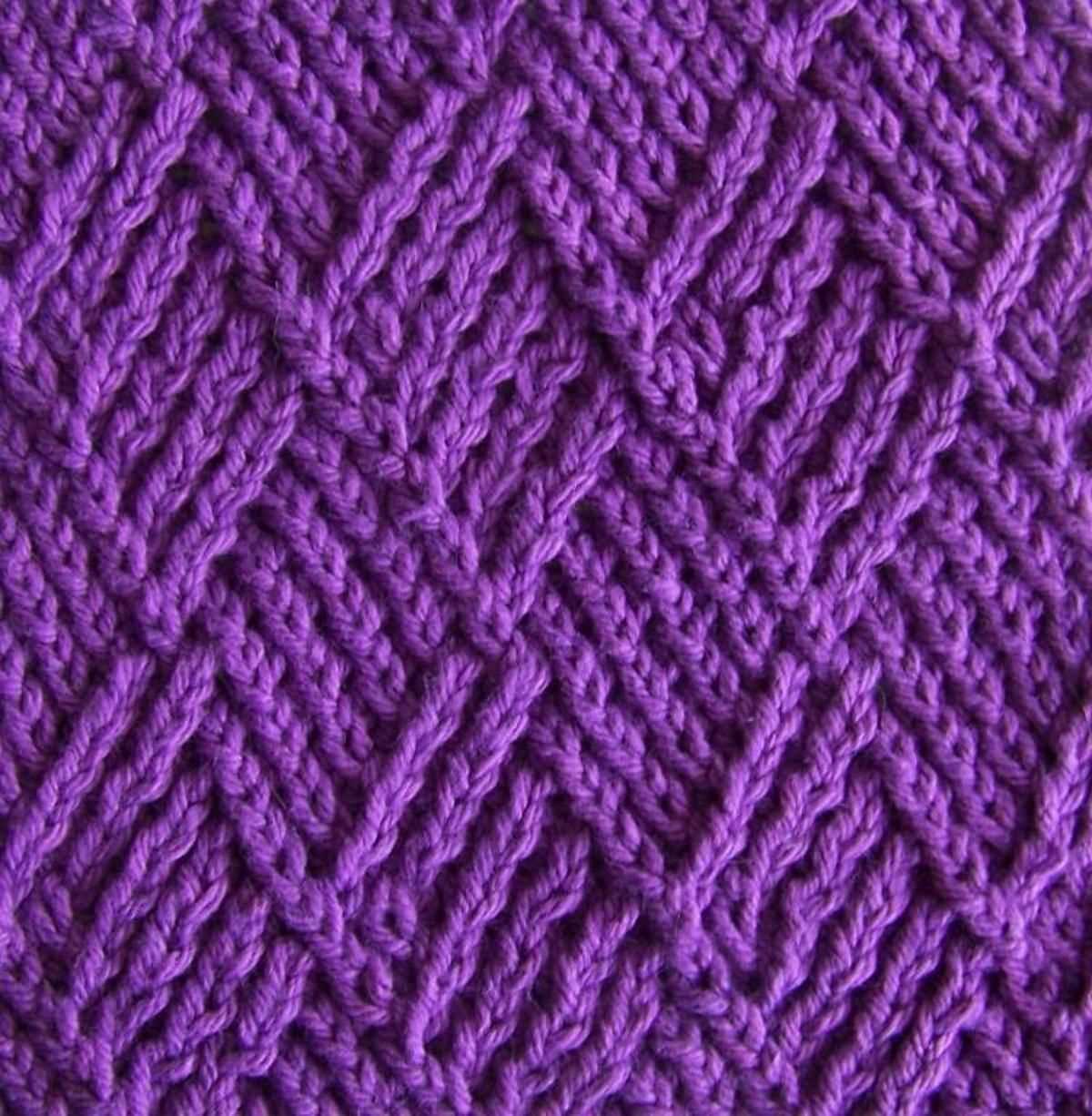
The diamond stitch pattern is a popular choice for knitters looking to add some texture and visual interest to their projects. To create this beautiful pattern, you will need a few key materials:
- Yarn: Choose a yarn that is suitable for the project you have in mind. For a cozy and warm result, opt for a natural fiber yarn like wool or alpaca. The weight and color of the yarn are also important considerations, depending on the desired outcome.
- Knitting Needles: Select knitting needles that are appropriate for the weight of the yarn you’ve chosen. The size of the needles will affect the overall gauge and drape of the finished project.
- Tapestry Needle: A tapestry needle is essential for weaving in ends and finishing your project. Look for one with a large enough eye to accommodate the yarn you’re using.
- Stitch Markers: Stitch markers can be helpful in keeping track of the pattern repeats, especially in more complex diamond stitch patterns. Choose markers that are easily visible and won’t snag or damage your yarn.
- Row Counter: A row counter is a handy tool for keeping track of your progress, particularly when working on larger projects. There are various types of row counters available, so choose one that suits your knitting style.
With these materials in hand, you’ll be well-equipped to tackle the diamond stitch pattern and create beautiful knitted pieces with an eye-catching design. Whether you’re making a cozy sweater, a stylish scarf, or decorative household items, the diamond stitch pattern is sure to add a touch of elegance to your knitting projects.
Step-by-Step Instructions for the Diamond Stitch Pattern
The diamond stitch pattern is a beautiful knit pattern that creates a textured diamond design. It adds depth and interest to any knitted project, making it a popular choice for blankets, scarves, and sweaters. Here are step-by-step instructions on how to knit the diamond stitch pattern.
Materials Needed:
- Yarn of your choice
- Knitting needles suitable for your yarn
- Tapestry needle
Instructions:
- Cast on an even number of stitches onto your knitting needles.
- Begin by knitting the first row, knitting each stitch.
- On the second row, purl each stitch.
- For the third row, start the diamond pattern. Knit the first stitch, then purl the next stitch.
- Continue alternating between knitting and purling stitches until the end of the row.
- On the fourth row, purl the first stitch, then knit the next stitch.
- Repeat steps 4-6 until you have reached the desired length of your project.
- Bind off all stitches on your final row.
The diamond stitch pattern is created by alternating between knitting and purling stitches on each row. This creates the diamond-shaped design. By following these step-by-step instructions, you can easily knit the diamond stitch pattern and create beautiful, textured projects.
Tips and Tricks for Knitting the Diamond Stitch Pattern
Knitting the diamond stitch pattern can create a beautiful texture and add visual interest to your projects. However, it can also be a bit challenging, especially for beginners. To help you master this stitch, here are some tips and tricks:
1. Use stitch markers
To keep track of the diamond pattern, it can be helpful to place stitch markers at the beginning and end of each diamond section. This will help you easily identify where the pattern starts and ends, making it easier to follow along.
2. Pay attention to your tension
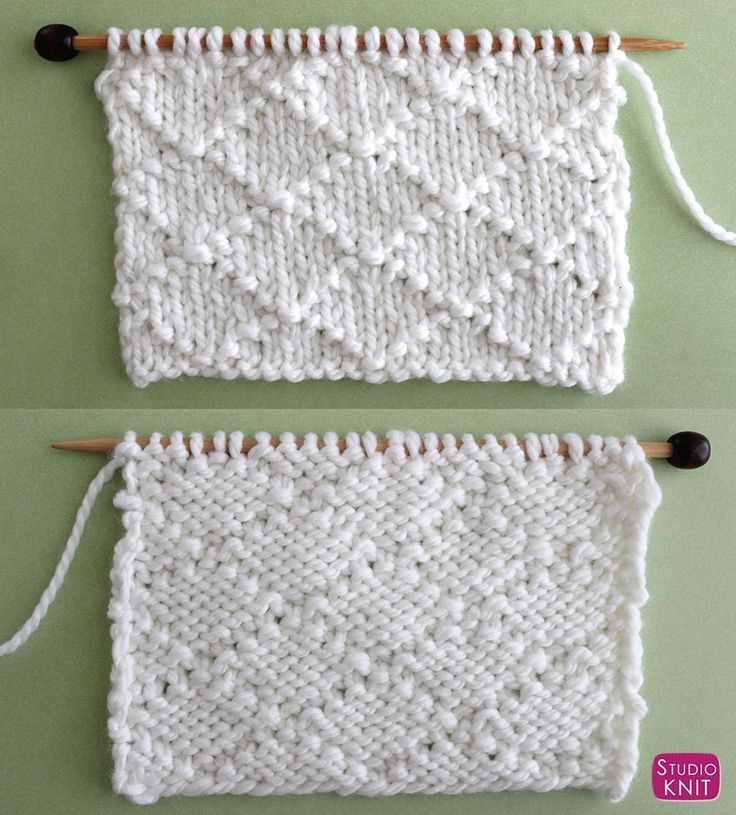
Consistent tension is crucial when knitting the diamond stitch pattern. Make sure not to pull your yarn too tightly or leave it too loose, as this can distort the shape of the diamonds. Take your time and practice maintaining an even tension as you work through the pattern.
3. Read the pattern carefully
Before starting your project, take the time to read through the diamond stitch pattern instructions carefully. Pay attention to any special stitches or techniques required, as well as any additional notes or tips provided. Understanding the pattern fully will help prevent mistakes and make the knitting process smoother.
4. Practice with scrap yarn
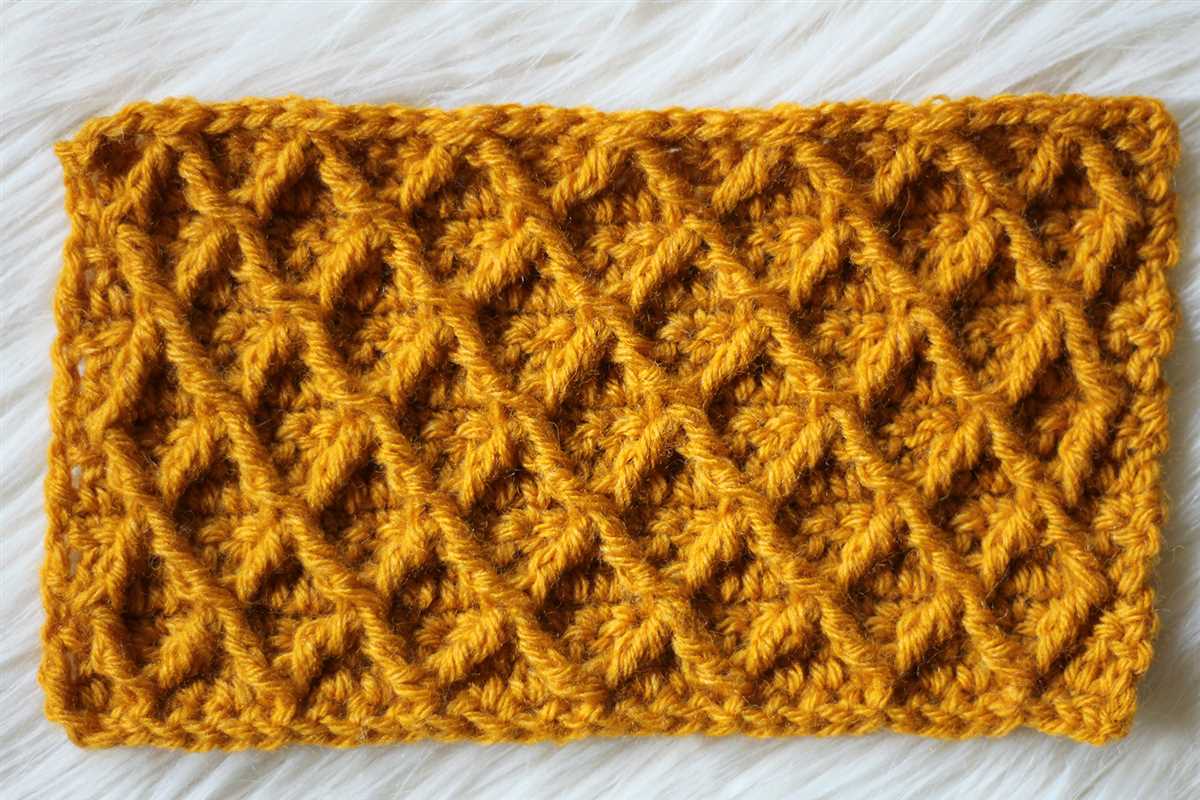
If you’re new to the diamond stitch pattern, it can be helpful to practice on a small swatch using scrap yarn. This will allow you to familiarize yourself with the stitches and get a feel for the pattern before committing to a larger project. It’s always easier to make mistakes and learn from them on a smaller scale.
5. Take breaks and stretch
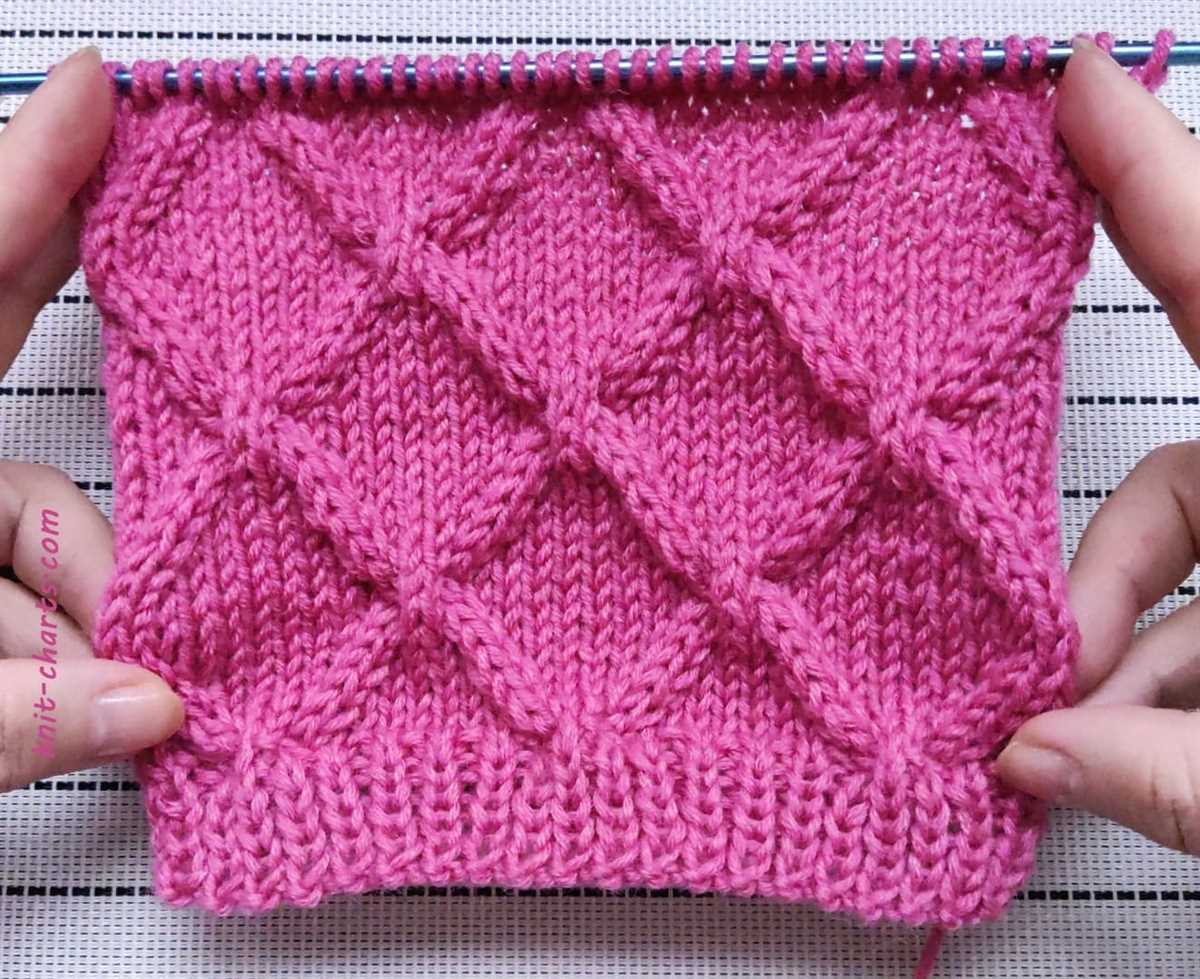
Knitting the diamond stitch pattern can require you to maintain a repetitive motion for an extended period. Make sure to take regular breaks to rest your hands and stretch your fingers. This will help prevent fatigue and strain, allowing you to knit more comfortably and efficiently.
By following these tips and tricks, you’ll be well on your way to knitting the diamond stitch pattern with confidence and creating stunning projects with intricate textures. Happy knitting!
Examples of Projects using the Diamond Stitch Pattern
The diamond stitch pattern is a popular choice among knitters for creating beautiful and intricate designs. Its unique diamond-shaped motif adds a touch of elegance and sophistication to any project. Here are a few examples of projects where the diamond stitch pattern can be used:
Sweaters and Cardigans
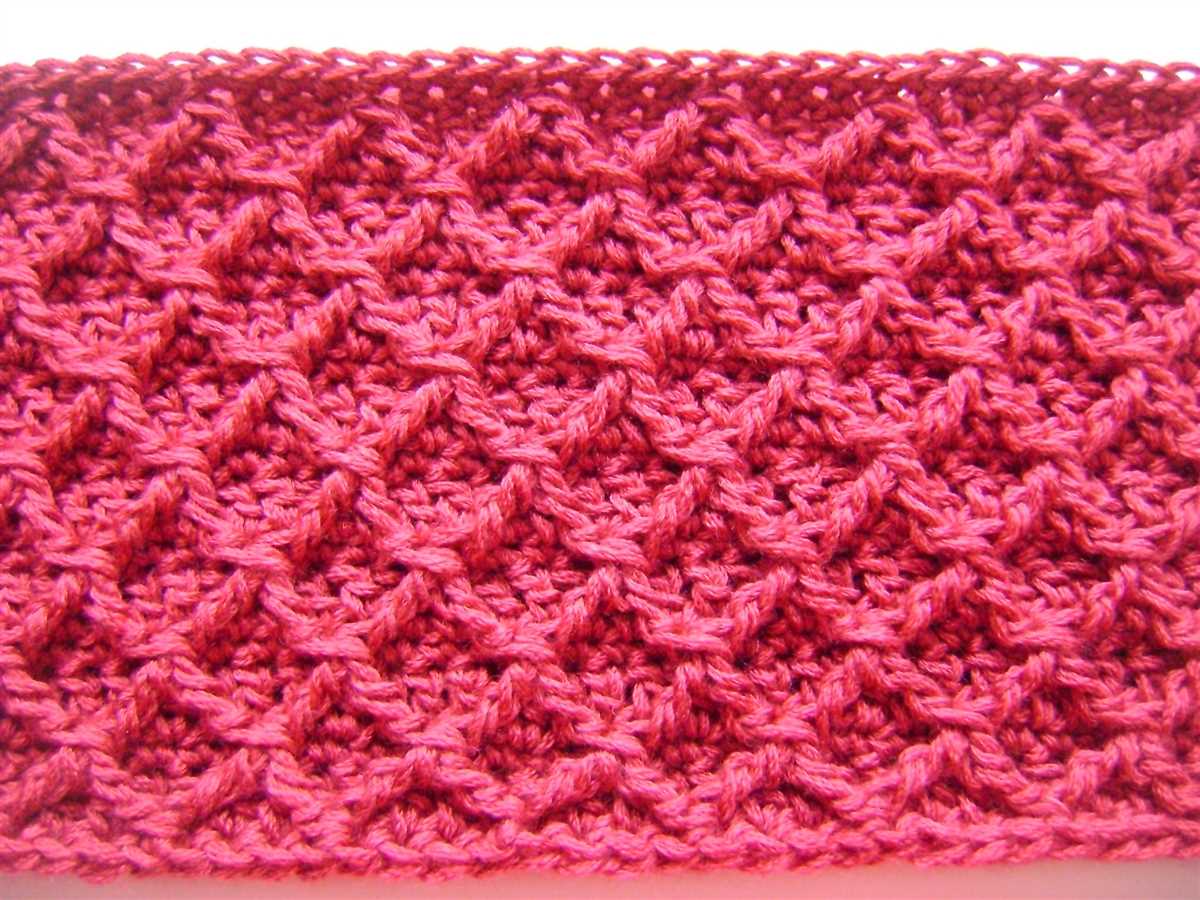
One of the most common uses of the diamond stitch pattern is in creating sweaters and cardigans. The geometric design of the diamond stitch adds texture and visual interest to the garment, making it a stylish and fashionable choice. Whether you knit a cropped sweater or a long cardigan, the diamond stitch pattern is sure to make your project stand out.
Scarves and Shawls
Another popular application of the diamond stitch pattern is in knitting scarves and shawls. The diamond motif adds a delicate touch to these accessories, making them perfect for adding a bit of flair to any outfit. Knit a cozy scarf in a solid color or experiment with different yarns to create a vibrant and eye-catching accessory. A diamond stitch shawl, on the other hand, can be a versatile and elegant addition to your wardrobe, suitable for both casual and formal occasions.
Blankets and Afghans
For those looking to create heirloom-quality pieces, the diamond stitch pattern can be used to knit stunning blankets and afghans. The repetitive pattern creates a visually pleasing design that is both cozy and comforting. Whether you choose to knit a baby blanket or a full-size afghan, the diamond stitch pattern will add a touch of luxury to your handcrafted creation.
Hats and Headbands
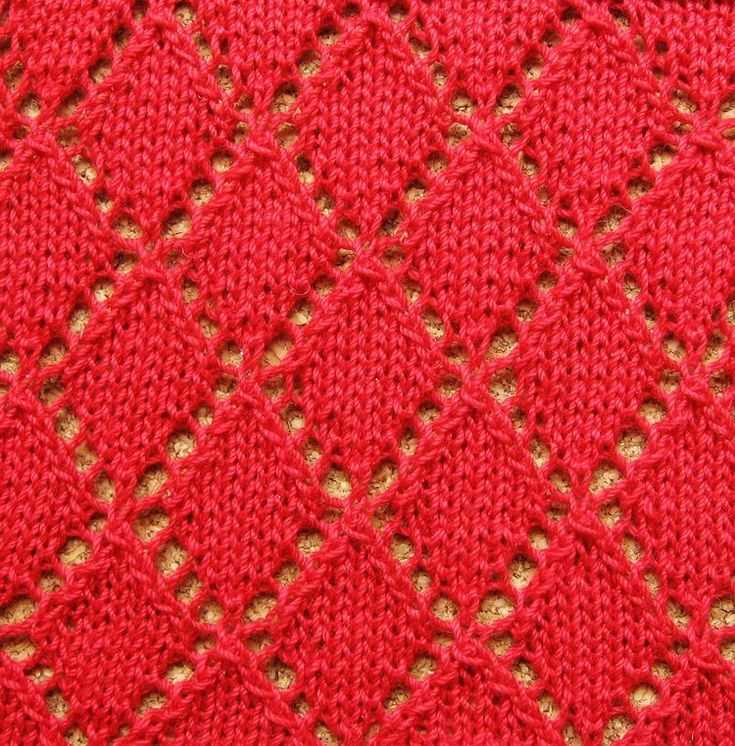
The diamond stitch pattern can also be incorporated into smaller projects such as hats and headbands. Knit a diamond stitch hat to keep you warm during the colder months, or create a stylish headband to jazz up your hairstyle. The versatility of the diamond stitch pattern allows for countless possibilities when it comes to accessories, making them an excellent choice for quick and satisfying knitting projects.
These are just a few examples of how the diamond stitch pattern can be used in knitting projects. Its versatility and beauty make it a popular choice among knitters of all levels. Whether you’re a beginner or an experienced knitter, the diamond stitch pattern is sure to add a touch of elegance to your next project.
Variations of the Diamond Stitch Pattern
The diamond stitch pattern is a classic knitting technique that creates a beautifully textured fabric. While the traditional diamond stitch pattern is commonly used in knitting, there are also several variations that add unique twists to this popular design. These variations can be incorporated into various knitting projects, allowing knitters to experiment and create their own unique designs.
1. Cable Diamonds: This variation combines the diamond stitch pattern with cable knitting techniques. Instead of traditional knit and purl stitches, cables are used to create a more intricate and dramatic diamond pattern. The result is a visually stunning fabric with an added layer of complexity.
2. Lacy Diamonds: For a more delicate and feminine look, lacy diamonds can be created by incorporating yarn overs and decreases into the traditional diamond stitch pattern. This creates a more open and airy fabric, perfect for lightweight garments or accessories such as shawls or scarves.
3. Intarsia Diamonds: Intarsia is a colorwork technique that allows knitters to create intricate patterns and designs using different colored yarns. By incorporating the diamond stitch pattern into intarsia knitting, you can create eye-catching and vibrant diamond motifs on your knitting projects.
4. Reversed Diamonds: A fun twist on the traditional diamond stitch pattern, reversed diamonds are created by working the stitches in the opposite direction. This variation creates an interesting visual contrast and adds a unique touch to any knitting project.
5. Diagonal Diamonds: Instead of working the diamond stitch pattern vertically or horizontally, diagonal diamonds are created by working the stitches on a diagonal line. This variation adds a dynamic and modern look to the fabric, making it perfect for contemporary garments and accessories.
Whether you stick to the traditional diamond stitch pattern or try out one of these variations, the diamond pattern is a timeless and versatile knitting technique that can be adapted to create a wide range of designs. So grab your needles and yarn, and let your creativity shine with the diamond stitch pattern!
Common Mistakes to Avoid when Knitting the Diamond Stitch Pattern
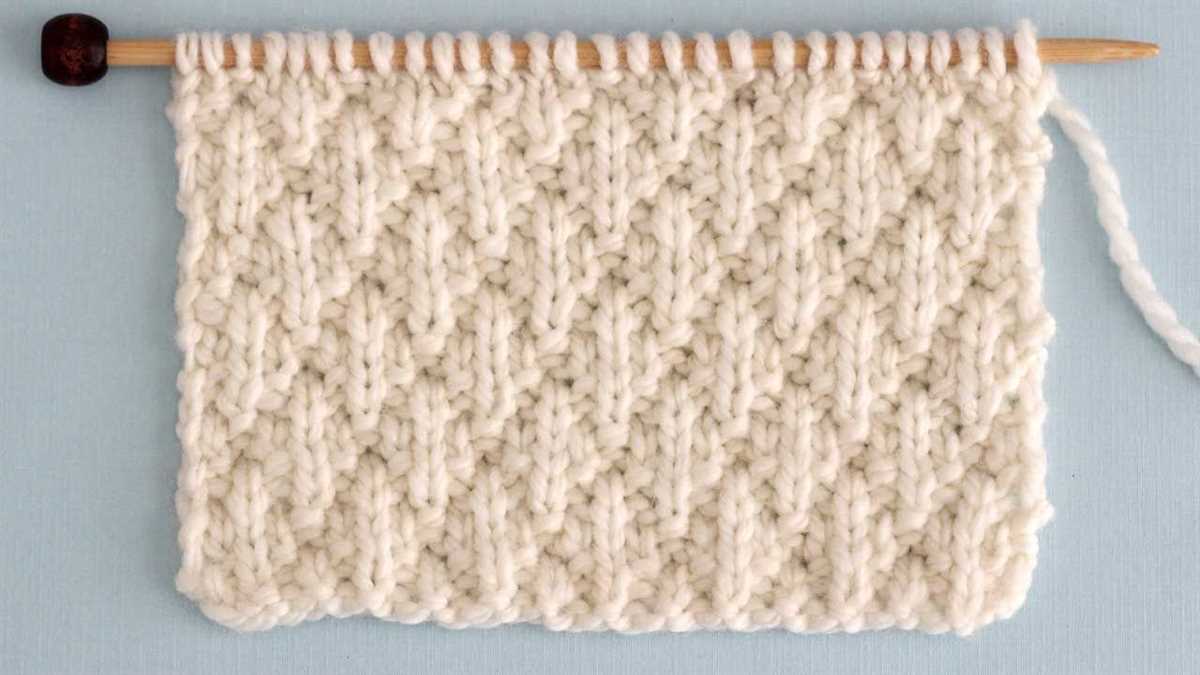
Knitting the diamond stitch pattern can be a challenging and rewarding experience. However, there are some common mistakes that beginners and even experienced knitters can make. By being aware of these mistakes, you can avoid frustration and ensure that your diamond stitch pattern turns out beautifully.
Using the wrong yarn weight
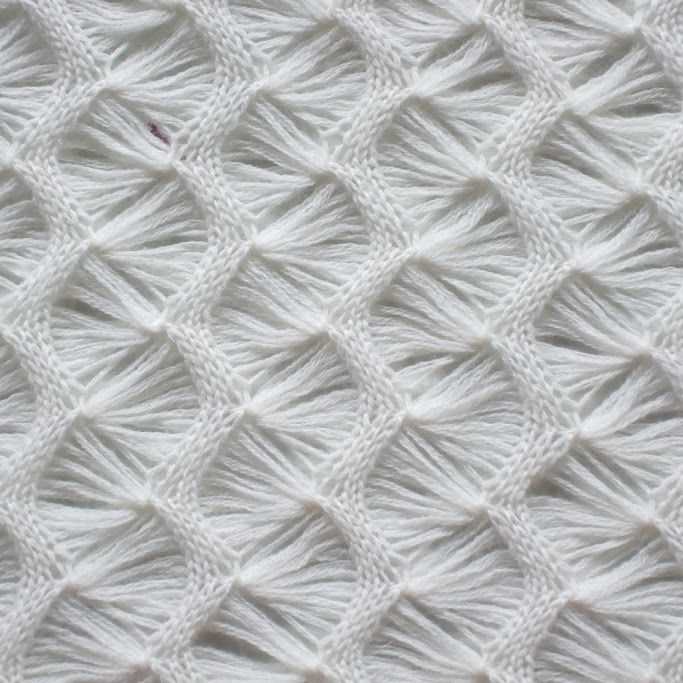
One common mistake when knitting the diamond stitch pattern is using the wrong yarn weight. The diamond stitch pattern typically looks best when knit with a lighter weight yarn, such as fingering or sport weight. Using a heavier yarn can result in a bulky and less defined pattern. It’s important to check the recommended yarn weight for the pattern and choose a yarn that matches accordingly.
Not counting stitches
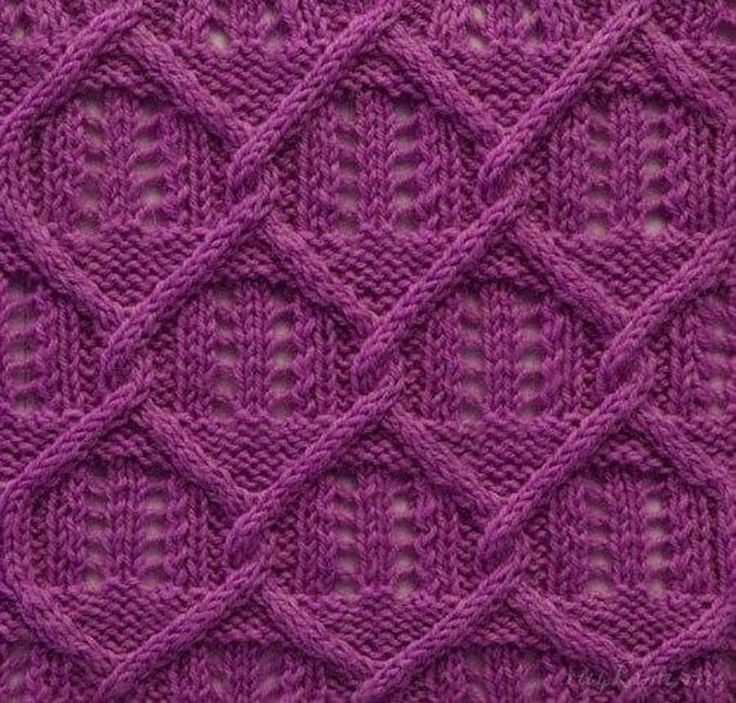
Counting stitches is crucial when knitting the diamond stitch pattern. It’s easy to get lost in the pattern and end up with the wrong number of stitches. Take the time to count your stitches regularly, especially at the end of each row or pattern repeat. Keeping track of your stitches will help ensure that your diamond stitch pattern stays symmetrical and consistent throughout.
Skipping the necessary increases and decreases
The diamond stitch pattern often requires specific increases and decreases to create the diamond shape. It’s important to carefully follow the pattern instructions and not skip these necessary steps. Skipping the increases or decreases can throw off the overall shape and structure of the pattern. Using stitch markers can also be helpful in keeping track of where these increases and decreases need to be made.
Not blocking the finished piece
Blocking is an essential step in finishing any knitting project, including the diamond stitch pattern. Not blocking your finished piece can result in an uneven and wrinkled appearance. Blocking helps even out the stitches and give the pattern a polished and professional look. Follow the recommended blocking instructions for your specific yarn and take the time to properly block your diamond stitch pattern.
Avoiding these common mistakes will help ensure that your diamond stitch pattern turns out beautifully and that you can fully enjoy the process of knitting it. Happy knitting!
Fixing Mistakes in the Diamond Stitch Pattern
The diamond stitch pattern is a beautiful and intricate knitting technique that adds texture and visual interest to any project. However, like any knitting pattern, mistakes can occasionally happen. Whether it’s a dropped stitch, a miscounted diamond, or an accidental yarn over, it’s important to know how to fix these mistakes in order to maintain the integrity of the pattern.
Dropped stitches: Dropped stitches are a common occurrence in any knitting pattern, including the diamond stitch. When you notice a dropped stitch, it’s important to address it right away to prevent unraveling. Carefully insert a crochet hook or knitting needle into the stitch below the dropped stitch, then use it to catch the dropped stitch and pull it up through the loop. Continue to work the row or round as usual, making sure the stitches are secure.
Miscounted diamonds: Occasionally, you may find that you’ve miscounted the number of stitches or rows in a diamond pattern. This can throw off the entire design and make it look uneven. The best way to fix this mistake is to carefully tink (undo) the incorrect stitches back to the point where the mistake was made. Then, rework the diamond pattern from that point, making sure to count the stitches and rows accurately.
Accidental yarn overs: Yarn overs are intentional in some knitting patterns, but in the diamond stitch pattern, they can be a mistake. If you accidentally make a yarn over in the wrong place, you may end up with extra stitches or gaps in the fabric. To fix this mistake, identify the yarn over, carefully drop it off the needle, and then insert the needle into the stitch below the yarn over. Use the working yarn to pull up the stitch, creating a new stitch without the extra yarn over. Continue knitting the pattern as usual.
Remember, mistakes happen to even the most experienced knitters. The key is to not panic and to take the time to fix the error properly. By addressing dropped stitches, miscounted diamonds, and accidental yarn overs as they occur, you can ensure that your diamond stitch pattern looks flawless and beautiful.
Other Knitting Patterns Similar to the Diamond Stitch Pattern
While the diamond stitch pattern is certainly beautiful and versatile, there are many other knitting patterns that you can explore if you’re looking for something similar. These patterns can add a touch of elegance and sophistication to your knitting projects. Here are a few examples:
1. Cable Knitting
Cable knitting is a technique that involves crossing stitches over each other to create intricate designs. Just like the diamond stitch pattern, cable knitting adds texture and dimension to your creations. You can create a variety of patterns like twists, braids, and ropes using cable knitting techniques.
2. Lace Knitting
Lace knitting is another popular technique that can give your projects a delicate and airy look. Lace patterns often feature decorative motifs like flowers, leaves, and openwork stitches. Just like with the diamond stitch pattern, lace knitting can be used to create beautiful shawls, scarves, and even garments.
3. Seed Stitch
Seed stitch is a simple yet visually appealing pattern that can be used as an alternative to the diamond stitch. This pattern involves alternating knit and purl stitches, creating a textured fabric with a subtle seed-like appearance. It’s a great option if you’re looking for a pattern that is easy to memorize and adds a classic touch to your knitting projects.
4. Basketweave Stitch
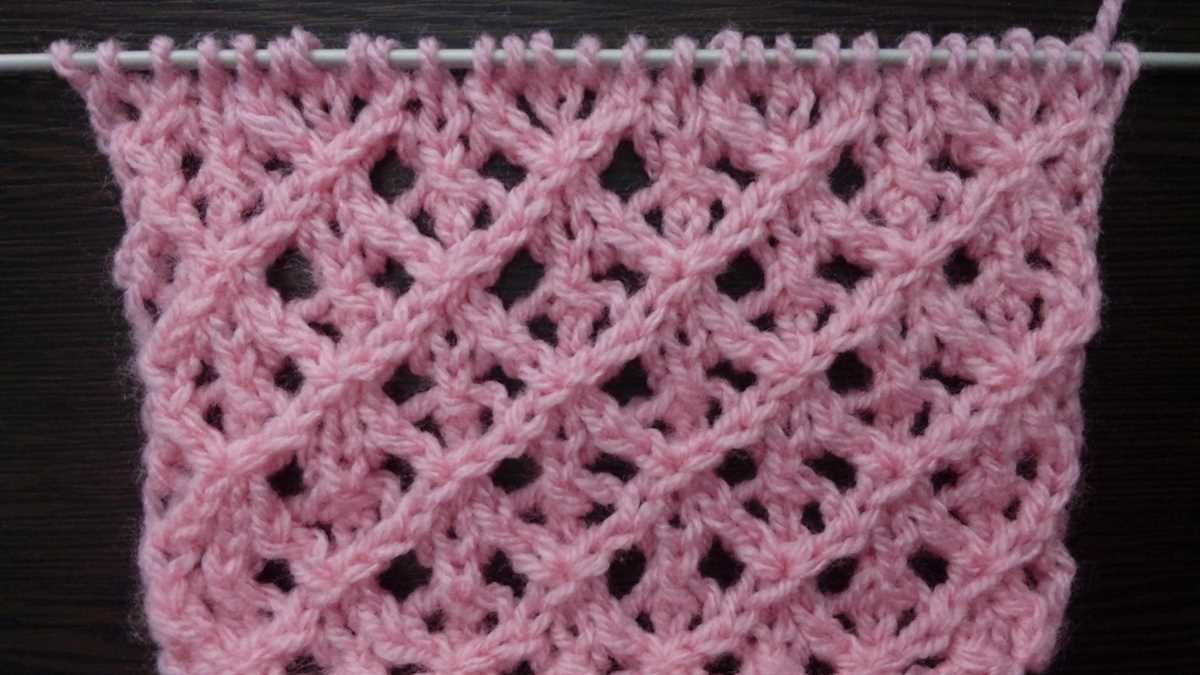
Basketweave stitch is a pattern that mimics the look of a woven basket. It uses a combination of knits and purls to create a checkerboard-like design. The texture of the basketweave stitch is similar to the diamond stitch, making it a great choice if you want to add some visual interest to your knitting projects.
These are just a few examples of knitting patterns that are similar to the diamond stitch pattern. Each of these patterns has its own unique charm and can be used to create stunning and eye-catching designs. Whether you’re a beginner or an experienced knitter, exploring different patterns will keep your knitting journey exciting and rewarding.